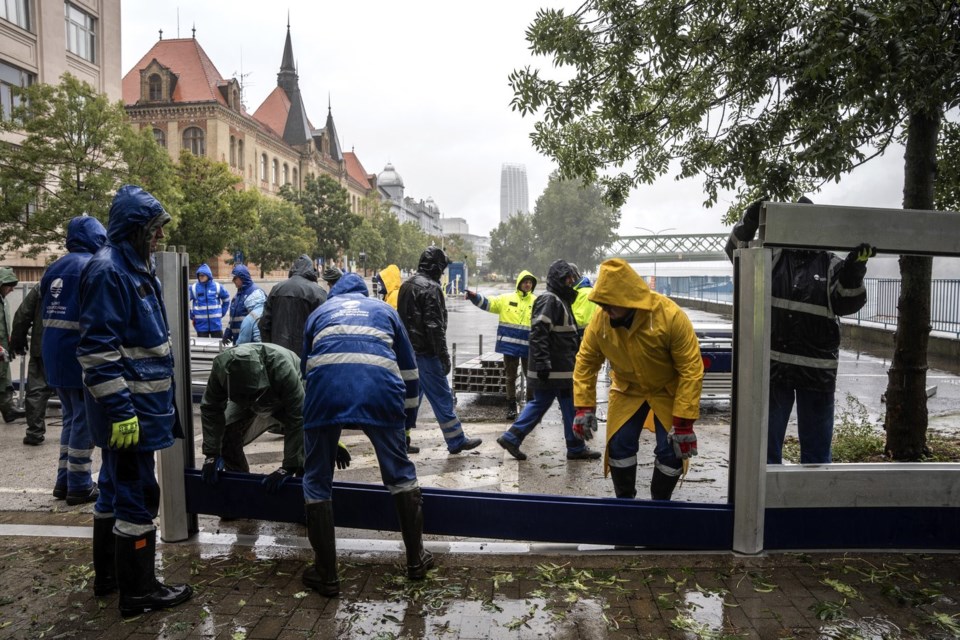PRAGUE (AP) — The death toll was rising in Central European countries on Sunday after days of heavy rains caused widespread flooding and forced evacuations.
Several Central European nations have already been hit by severe flooding, including Austria, the Czech Republic, Poland and . Slovakia and Hungary might come next as a result of a low pressure system from northern Italy dumping record rainfall in the region since Thursday.
The floods have claimed six lives in Romania and one each in Austria and Poland. In the Czech Republic, four people who were swept away by waters were missing, police said.
It's not over yet
Most parts of the Czech Republic have been affected as authorities declared the highest flood warnings at around 100 places across the country. But the situation was worst in two northeastern regions that recorded the biggest rainfall in recent days, including the Jeseniky mountains near the Polish border.
In the city of Opava, up to 10,000 people out of a population of around 56,000 have been asked to move to higher ground. Rescuers used boats to transport people to safety in a neighborhood flooded by the raging Opava River.
“There’s no reason to wait,” Mayor Tomáš Navrátil told Czech public radio. He said that the situation was worse than during the last devastating floods in 1997, known as the “flood of the century.”
“We have to focus on saving lives,” told Czech public television on Sunday. His government was set to meet Monday to assess the damages.
The worst “is not behind us yet,” the prime minister warned.
President Petr Pavel sounded more optimistic, saying “it's obvious we've learned a lesson from the previous crisis.”
At least 4 missing and villages cut off
Thousands of others also were evacuated in the towns of Krnov, which was almost completely flooded, and Cesky Tesin. The Oder River that flows to Poland was reaching extreme levels in the city of Ostrava and in Bohumin, prompting evacuations.
Ostrava, the regional capital, is the third-largest Czech city. Mayor Jan Dohnal said the city will face major traffic disruptions in the days to come. Almost no trains were operating in the region.
Towns and villages in the Jeseniky mountains, including the local center of Jesenik, were inundated and isolated by raging waters that turned roads into rivers. The military sent a helicopter to help with evacuations.
Jesenik Mayor Zdenka Blistanova told Czech public television that several houses in her and other nearby towns have been destroyed by the floods. A number of bridges and roads have been badly damaged.
About 260,000 households were without power Sunday morning in the entire country, while traffic was halted on many roads, including the major D1 highway.
A firefighter dies as Lower Austria declared a disaster zone
A firefighter died after “slipping on stairs” while pumping out a flooded basement in the town of Tulln, the head of the fire department of Lower Austria, Dietmar Fahrafellner, told reporters on Sunday.
Authorities declared the entire state of Lower Austria in the northeastern part of the country a disaster zone, while 10,000 relief forces have so far evacuated 1,100 houses there. Emergency personnel have started setting up accommodation for residents who had to flee their homes due to the flooding.
The municipality of Lilienfeld with about 25,000 residents is cut off from the outside world. Residents were told to boil tap water as a precaution.
The situation is particularly dangerous along the Kamp River, which flows into the Danube. The Ottenstein reservoir on the river functions as a buffer, but exceeding its limits could cause more flooding, experts say.
Austrian Chancellor Karl Nehammer said the situation “continues to worsen.” He said 2,400 soldiers were ready to support the relief effort in Austria. Of those, 1,000 soldiers will deploy to the disaster zone in Lower Austria, where dams were beginning to burst.
“We are experiencing difficult and dramatic hours in Lower Austria. For many people in Lower Austria these will probably be the most difficult hours of their lives,” said Johanna Mikl-Leitner, the governor of Lower Austria.
In Vienna, the Wien River overflowed its banks, flooding homes and forcing first evacuations of nearby houses.
Romania reports 2 more flooding victims
Romanian authorities said Sunday that another two people had died in the hard-hit eastern county of Galati after there a day earlier, following unprecedented rain.
Dramatic flooding in Poland
In Poland, one person was presumed dead in floods in the southwest, said Sunday.
Tusk said the situation was “dramatic” around the town of Klodzko, with about 25,000 residents, located in a valley in the Sudetes mountains near the border with the Czech Republic. Helicopters were used to pick up people from roofs in a few cases.
In Glucholazy, rising waters overflowed a river embankment and flooded streets and houses. Mayor Paweł Szymkowicz said, “we are drowning,” and appealed to residents to evacuate to high ground.
A bridge in the town collapsed under the flood pressure and a police station building was knocked down in Stronie ĹšlÄ…skie, after floodwaters burst through a dam. Submerged cars could be seen in many places in the KĹ‚odzko Valley region bordering the Czech Republic, while a new flood wave was expected there.
In the city of Jelenia Gora, which has 75,000 residents, downtown streets were flooded after one of the embankments burst on the Bobr River. City authorities have warned residents they may need to evacuate as more flooding was moving toward the city.
Energy supplies and communications were cut off in some flooded areas, and regions may resort to using the satellite-based Starlink service, Tusk said.
The weather change arrived following a hot start to September in the region. Scientists have documented , breaking a record set just a year ago.
A hotter atmosphere, driven by , can lead to more intense rainfall.
___
Monika Scislowska in Warsaw, Poland, Philipp-Moritz Jenne and Stephanie Liechtenstein in Vienna, and Stephen McGrath in Sibiu, Romania, contributed to this report.
Karel Janicek, The Associated Press




